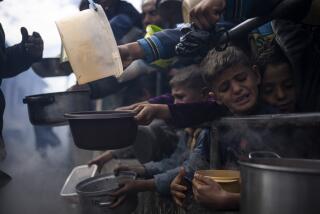Theft of Afghan Aid Is Considered Rife
- Share via
ISLAMABAD, Pakistan — After years of providing the basic necessities of life for up to 2 1/2 million Afghan refugees, aid officials in Pakistan say it is time to count heads to see who is left to collect the mountain of relief goods.
The U.N. High Commission for Refugees and other U.N. agencies fear that the total number of refugees is much lower than earlier estimates, although the agencies were never informed of the population decline in the camps.
“Thus we have been giving millions of dollars in aid for the refugees who do not exist,” a U.N. official said. “This money is stolen by corrupt officials, Afghan functionaries of the refugee camps and refugee leaders.”
The Ministry of State and Frontier Regions, which administers the refugee operation with the U.N. agencies, has ordered a survey of the camps to see just how many Afghans are left.
An estimated 2 1/2 million Afghans crossed into neighboring Pakistan beginning in 1979 after Soviet troops invaded their country and set up a Communist government.
The influx continued for many years as Afghan civilians sought to escape the bloody civil war between the Soviet-supported Kabul government and Western-backed moujahedeen guerrillas.
“Pakistan did an unprecedented job in looking after the world’s biggest refugee population,” the U.N. official said. “They gave them food, money, houses and even work.”
But the refugee official, who asked not to be identified by name, said aid became a big business “with lots of money in it for the corrupt officials, refugee leaders and others.”
According to an estimate provided earlier by the Pakistan government and refugee leaders, there were 850,000 refugees in Baluchistan, Pakistan’s largest province.
However, a recent house-to-house survey in some camps by U.N. agencies showed the real refugee population in Baluchistan was about 360,000--only 42% of the official estimate.
The U.N. complained that Pakistani officials and Afghan camp leaders collected the aid meant for 850,000 refugees in Baluchistan and distributed it among only 360,000 people.
The survey also showed that almost 60% of the 14,000 registered households in those camps had bogus ration cards. A U.N. official said camp leaders keep 25% of the total ration cards issued to a camp and collect the rations for themselves, selling the wheat, edible oils and kerosene in the local market.
A U.N. survey completed in December confirmed reports that the real refugee population in the camps was much lower than the official figures. The survey also indicated “a substantial repatriation movement of refugees to Afghanistan.”
The United Nations has recommended to its agencies, the World Food Program and other donor organizations that they adjust their aid commitments according to the real refugee population, a Pakistani official said.
It was estimated that the camp leaders and Pakistani officials have made as much as $8 million over the years by selling the wheat collected on false ration cards on local markets in Baluchistan.
Proceeds from other commodities such as edible oils and kerosene were not included in the $8 million figure, they said.
An international team set up last year to look into the corruption charges estimated that Pakistani authorities and Afghan camp leaders skim off about 10% of all wheat and edible oil distributed among the refugees.
The worst sufferers are the hundreds of thousands of unregistered refugees who get no aid and instead have to buy wheat and other commodities at the black market rate.
More to Read
Sign up for Essential California
The most important California stories and recommendations in your inbox every morning.
You may occasionally receive promotional content from the Los Angeles Times.










